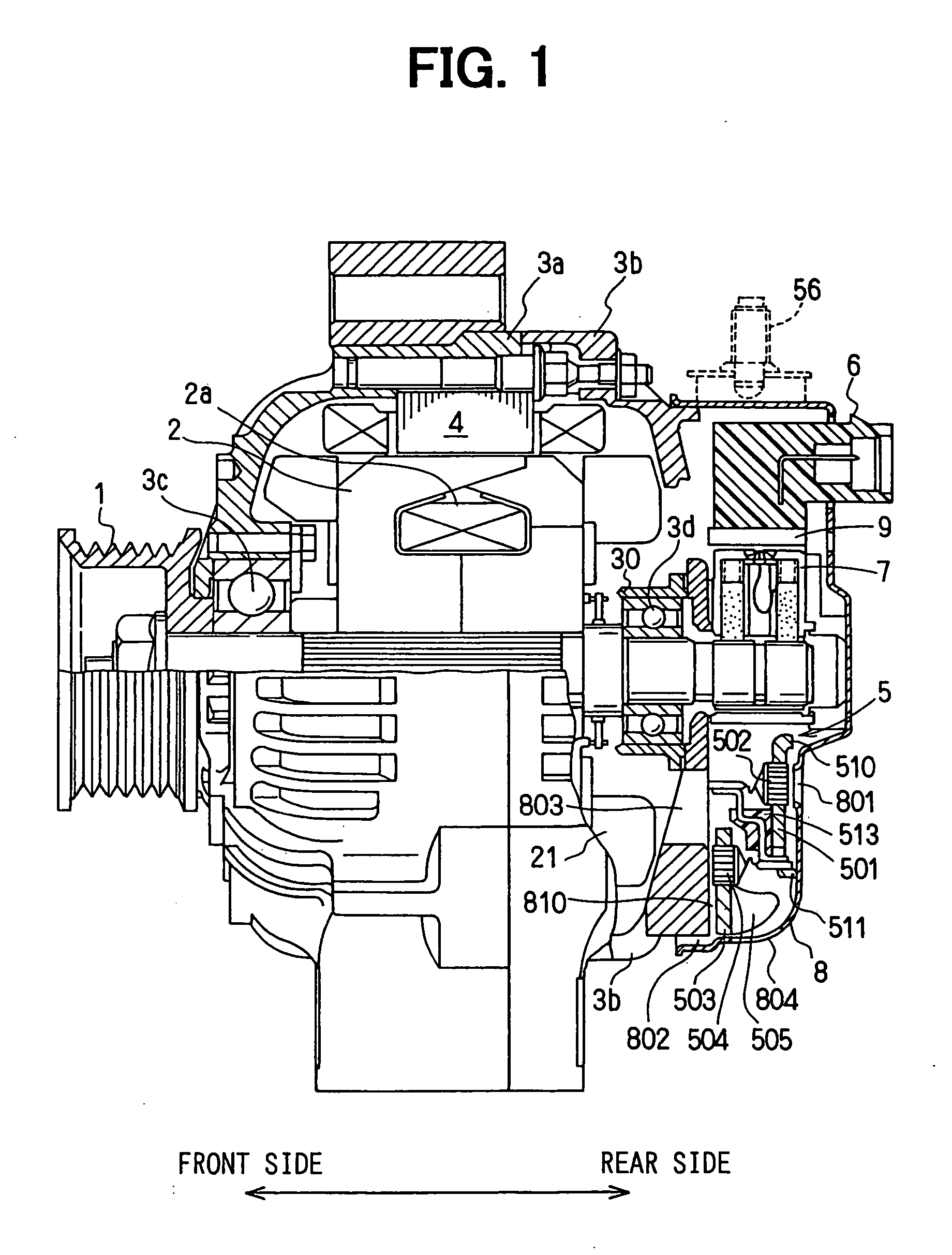Automotive alternator having rectifier mounted on heatsink plate with cooling fins
a technology of heatsink plate and rectifier, which is applied in the direction of magnetic circuit rotating parts, magnetic circuit shape/form/construction, windings, etc., can solve the problems of high temperature in the engine compartment, unavoidable temperature rise in the alternator, and high water splashing by tires or foreign particles into the engine compartment, so as to improve the cooling efficiency
- Summary
- Abstract
- Description
- Claims
- Application Information
AI Technical Summary
Benefits of technology
Problems solved by technology
Method used
Image
Examples
first embodiment
[0031] the present invention will be described with reference to FIGS. 1-6. An alternator is composed of: a housing including a front frame 3a and a rear frame 3b (a front side and a rear side of the alternator are indicated in FIG. 1); a cylindrical stator 4 having an armature coil, the stator being contained in the housing; a rotor 2 having a field coil 2a, the rotor 2 being rotatably supported by bearings 3c, 3d inside the cylindrical stator 4; a pulley 1 connected to the rotor 2 for transmitting a rotational torque from an engine; a rectifier 5 for converting alternating current generated in the armature coil into direct current, the rectifier 5 being mounted on the rear frame 3b; a brush holder 7 holding brushes for supplying current to the field coil 2a; a regulator 9 for controlling an output voltage to a predetermined voltage; a connector case 6 for electrically connecting alternator to an outside circuit; a rear cover 8 made of resin for covering the rectifier 5, the regula...
second embodiment
[0040] the present invention will be described with reference to FIG. 7. The air passage 810 leading the cooling air from the radial air gap 802 to the air inlet 803 may be constituted as shown in FIG. 7. Plural ditches forming the air passage 810 and plural projected surfaces 811 contacting the minus heatsink plate 503 are alternately formed on the rear frame 3b. The ditches and the projected surfaces are formed along radial lines converging to the center of the alternator. An air passage 810a facing a back surface of the minus diode 504 mounted on the minus heatsink plate 503 may be made shallower than other air passages 810, as shown in FIG. 7. In addition to making a direct contact between the projected surfaces 811 and the minus heatsink plate 503, a heat-conductive material such as heat-conductive grease may be placed therebetween. The plural projected portions forming the projected surfaces 811 also function as additional cooling fins. By constituting the air passage 810 in t...
third embodiment
[0041] the present invention will be described with reference to FIG. 8. In this embodiment, the rear cover 8 is eliminated, and the rear bearing 3d is disposed on the rear most end of the rear frame 3b. The rectifier 5 is disposed in a space between the rear frame 3b and a separating wall 10. Axial openings 801 a are formed on the axial end wall of the rear frame 3b, and radial openings 802a, 802b are formed on the radial wall of the rear frame 3b.
[0042] The rectifier 5 includes an outer heatsink plate 503a on which the plus diodes 502 are mounted and an inner heatsink plate 501a on which the minus diodes 504 are mounted. When the cooling fan 21 is rotated, cooling air introduced from the axial openings 801a is sucked into an air inlet port 101 formed on the separating wall 10 after cooling the inner heatsink plate 501a. Cooling air introduced from the radial openings 802b passes through the cooling fins 505 formed on the outer heatsink plate 503a and flows into the inner space th...
PUM
 Login to View More
Login to View More Abstract
Description
Claims
Application Information
 Login to View More
Login to View More - R&D
- Intellectual Property
- Life Sciences
- Materials
- Tech Scout
- Unparalleled Data Quality
- Higher Quality Content
- 60% Fewer Hallucinations
Browse by: Latest US Patents, China's latest patents, Technical Efficacy Thesaurus, Application Domain, Technology Topic, Popular Technical Reports.
© 2025 PatSnap. All rights reserved.Legal|Privacy policy|Modern Slavery Act Transparency Statement|Sitemap|About US| Contact US: help@patsnap.com



